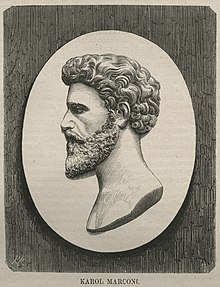Karol Antoni Marconi

Karol Antoni Marconi (born November 18, 1826 in Warsaw , † October 25, 1864 in Florence ) was a Polish painter.
Marconi was the son of Enrico Marconi and his wife Małgorzata (1807-1884). His brothers were Leandro and Władysław Marconi . His grandfather was the Italian painter and architect Leandro Marconi . Marconi was married to Emilia Gawęcka (1834-1902).
After graduating from a high school in Warsaw, Marconi studied the fresco painter Marcantonio Chiarini in Italy ; his first works were wall paintings in the Wilanów Palace . In 1844 he went back to Italy for further studies, where he devoted himself to drawing and wall painting in the monumental style. During his numerous journeys he became chronically ill, which later forced him to go to health resorts.
In 1850 he returned to Warsaw and took over work in the Marconi Palace, which no longer exists, and in the hall of the Institute for the Blind and Deaf on Plac Trzech Krzyży . This was followed by commissioned work in the Kronenberg Palace and in the Hotel Europejski . His most important work was the design of the meeting room of the National Credit Society of the Kingdom of Poland (Polish: Towarzystwo Kredytowe Ziemskie w Królestwie Polskim ), today the seat of the Ethnographic Museum .
Marconi was now increasingly suffering from attacks of tuberculosis , which made his work - often performed in the supine position - difficult. Nevertheless, he decorated the St. Anna parish church in Wilanów (Polish: Kościół św. Anny ) and the Church of the Immaculate Conception (Polish: Kościół Niepokalanego Poczęcia ) in Grzybów with wall paintings. Two pictures were also created for the burial chapel of the Carmelite Church (Polish: Kościół Wniebowzięcia Najświętszej Maryi Panny i św. Józefa Oblubieńca ) in Warsaw.
Marconi died of tuberculosis on a trip to Florence at the age of 37. In addition to his completed works, he left behind many sketches, especially charcoal drawings.
Web links
- Detailed biography in Tygodnik Ilustrowany from 1865 (in Polish)
References and comments
- ↑ The hall was destroyed during the Second World War
| personal data | |
|---|---|
| SURNAME | Marconi, Karol Antoni |
| BRIEF DESCRIPTION | Polish painter |
| DATE OF BIRTH | November 18, 1826 |
| PLACE OF BIRTH | Warsaw |
| DATE OF DEATH | October 25, 1864 |
| Place of death | Florence |